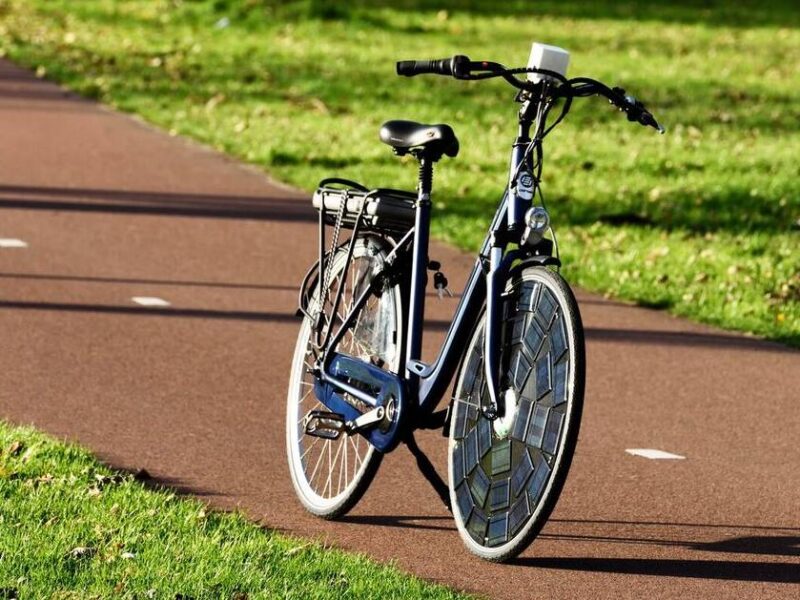
Modular and mobile photovoltaics on wheels
Sporting a 250W front-wheel integrated electrical engine, a 400W 36V 11A battery and 60 mini solar panels which provide the S-bike with an average of 35 to 40Wh per hour during daytime under the fairly clouded Dutch skies, the prototype was proving enough for the startup to secure strong partnerships with well-established bicycle manufacturers.
The first prototype was designed based on mono crystalline cell technology but the company is working in close cooperation with the Delft University of Technology to develop a second prototype based on amorphous silicon, hopefully ready within the next 6 to 12 months.
Although organic flexible photovoltaics are on its radar, the startup sees them as a longer term prospect, knowing that its energy harvesting architecture is cell-technology agnostic and could accommodate any new photovoltaic configuration.
To make the most of each individual panel, the S-bike relies on a patented nano-inverter architecture which the company says makes the cluster of cells more efficient and ensures a stable power output, even under partial shading or at varying light angles.
Having proven the concept, Solar Application Lab hopes to co-develop a solar e-bike with partners from the cycle industry, to whom it would then license the nano-inverter IP.
“In fact, the Solar Cycle is a vehicle for our IP”, told us Marc Peters, the company’s Founder and Managing Director.
“We couldn’t work with existing micro-inverters from the photovoltaics industry, those would have been an overkill for our application. So we had to build our own architecture from discrete components” he explained.

Solar Application Lab well beyond the
e-bike market, managing unique solar tile designs.
“Our nano-inverter can work with any type of solar cell in any cluster configuration, on a small scale” he continued. The Solar Cycle is a starter, aimed at the booming e-bike market. If it becomes a success, maybe the company will have the multi-million euros budget to turn its IP into silicon.
“We want to design an ASIC for it, most definitely” said Peters, hinting at the 130 or 90nm nodes, “or maybe two or three product versions to cater for 80 to 90% of the market for small scale modular photovoltaics”. For example, derivative products enabled by such an all-silicon nano-inverter could include unique photovoltaic tiles designed to be laid out in clusters of any size.
In volume production, a chip solution could take the costs down dramatically compared to today’s discrete board designs, estimates Peters, it would also help the company diversify its market, say to design readily connectable photovoltaic tiles.
Solar Application Lab has received approximately 250,000 euros of seed funding (the company was created in July 2014), and is currently setting up a collaboration programme of 1.2 million euros with undisclosed companies willing to co-develop a commercial product.
“The prospect investors aren’t specifically linked to the bike industry”, clarifies Peters, “because even though the bike application is linked to the ASIC business case, the two don’t necessarily have the same investment scopes. Solar Application Lab needs to raise approximately 400 to 500k for the next two years”.
The Solar Cycle as an affordable and green mean of transportation is only one part of the story, though. Peters wants to exploit the modular and mobile solar concept further, by making the solar panels removable, maybe to be affixed to a building’s wall upon arrival.

Or alternatively, when not in use, the e-bikes could contribute to a city’s smart power grid, when plugged into dedicated infrastructure (akin to electric cars today).
Peters is planning to launch a crowdfunding campaign this summer. He hopes the campaign’s story telling will help mobilize not only early adopters but also incubators and policy makers from cities with strong ambitions to pioneer green and smart infrastructures.
Visit Solar Application Lab at www.solarapplab.com
Related articles:
Italian startup wants to speed up transition to EVs
The route to cleaner e-cars – coupling perovskite solar cells
Hublex: a custom fit for industrial mobility
Stanford’s solar car uses STM32s for subsystems
London to be European electromobility capital
 If you enjoyed this article, you will like the following ones: don't miss them by subscribing to :
eeNews on Google News
If you enjoyed this article, you will like the following ones: don't miss them by subscribing to :
eeNews on Google News



